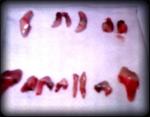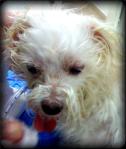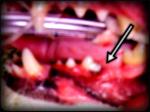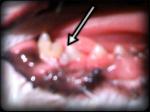6-Year Old Maltese Needs 12 Teeth Removed
Or, How 3 of Those Teeth Could Have Been Saved
Including 3 Questions All Pet Parents Ask When They Are Told Teeth Need Extraction
Also Including the Important Tip: What Are the Most Important Teeth?
Bennie’s Bad Breath
A little white fluffy dog trimmed in a two-inch puppy cut wagged his whole hind end along with his tail as Doc Springer patted his head and leaned in to check his teeth.
Benny had terrible breath! His front incisors moved a little when yours Truli touched them lightly. His molars were hard to get a good look at because he wiggled so much, but the Doc could see some of them overlapped and they were covered with tartar.
“Bennie needs to undergo dental surgery,” Doc Springer said.
“But he’s only six years old!” mom said.
“Almost all dogs his age have periodontal disease unless they’ve had their teeth brushed pretty much daily,” Doc Springer reassured,”Once his teeth are cleaned, assessed, and taken care of, we can teach you how to keep his teeth healthy from now forward.”
Bennie’s mom left him for the day for dental surgery.
Bennie’s Dental Day
First, Bennie had his pre-op EKG (painless) and his pre-op bloodwork. The nurses put an IV in his little arm, and he got some diazepam (one brand name is valium) to help relax him for the anesthesia.
Bennie’s anesthesia went well, but his dental exam was horrendous. The incisors were loose (useless). 3 major molars had one abscessed root and one or two normal roots. The rest of the diseased teeth were rotten premolars.
In fact, one of the premolars was damaged because a baby tooth was stuck under the gums and never fell out. Two other molars were damaged because their neighboring teeth crowded them, leaving no room for healthy gums, or tooth sockets.
Doc Springer says,”Everytime I call a pet parent to tell them teeth have to be extracted, everyone asks the same questions:
1-How will he (or she) eat?
A-Better than with rotten, painful teeth.
2-How many teeth will be left?
Comment-Doctors always focus on how many will come out, it takes extra effort and time for us to flip the perspective and have the answer ready for you. I take the extra minute because everyone, bar none, asks this question.
3-Is that the best price you can do?
A-No matter if your vet charges $10 or $100 or $1,000 for dental work, it always feels like “extra.” Probably, this has to do with the absolute fact that no vet can predict how much disease will be found until x-rays are analyzed. And no pet sits still for x-rays of the delicate mouth structures without anesthesia. So your pet will never have a firm cost estimate before you leave him or her for the procedure.”
Unnerving, I know. And to top off your feeling of being cornered, you really do not want your beloved to undergo another anesthetic procedure just because you were not financially prepared for any outcome! That’s just the physics and biology of the situation!
Treatment Options for Bennie
Those 3 important large molars had two treatment options. The first was extraction (which we ended up performing because the second option was too expensive for Bennie’s folks.) Let me explain how those 3 teeth could have been saved with option 2. But first, a little lesson in tooth priorities.
What Are “Important Teeth?
There are 8 “important” teeth in a dog’s mouth. The four canine, or eye teeth, you see in the front. Then there are two big molars (technically, premolars) on the right and left upper arcade. They are called carnassial teeth. They each have three roots, two toward the front and one toward the back of the mouth. The other two integral teeth are the big bottom molars on right and left. These bottom teeth each have two roots.
These molars can look normal to the eye, and they will not wiggle when examined, because one root may be damaged while the other root or roots are solid. Between a careful exam with periodontal probes under anesthesia and dental x-rays, the pattern of disease is revealed. If only one root is damaged on one of these molars, the tooth can be saved.
How Molars Can be Saved
“How can we save molars?” you ask.
The molars are sectioned in half. The useless, diseased half is removed from the mouth altogether. The remaining healthy part of the tooth now has a hole into the pulp and no enamel to protect the cut surface. Root canal therapy fills and seals the remaining canal, so there is no pain and no infection can attack the inside of the tooth. A mold is made of the tooth.
In a separate anesthetic procedure, a crown replaces the original chewing surface and appearance of the tooth! This surgery does not replace the need for daily toothbrushing. The saved root can still get disease around the tooth (called the periodontum), become loose, and be lost.
The financial expense? The same as for a person! This kind of advanced salvage and reconstructive work is usually best performed by a board certified veterinary dental specialist.
Bennie Came Through Like a Champ!
Bennie’s parents wished to save his molars, but would have needed to wait a year to save up the money for three root canals and crowns. Bennie could not stand the pain and disease for another day, let alone a year! All of the useless, diseased teeth left his mouth that day.

The Dirty Dozen (Apologies for the lack of focus) The premolars on the bottom were not broken on removal, the roots were rotted away!
After surgery, Bennie rested comfortably with his strong opioid painkillers. After arriving home, he seemed just like his old self! Bennie even still eats dry dog food, even without those 12 teeth.
(Note: It looks like more than twelve teeth in the picture because some of the teeth have been cut in half, and do not count as 2 teeth.)






Hi,
My little guy goes in tomorrow for probably the same dental surgery your little Bernie had. Milo is 8 years old and has between Stage 3 and 4 Periodontal disease. Loose teeth in the front. I’ve been nervous about having him put under, but your article eased my fears a bit. Thank You for posting. I hope little Bernie is well.
Let us know how Milo does. He’ll feel so much better when he’s done!
Yours,
Doc Truli
I have been using liquid toothbrushing drops rather than brushes with tooth PASTE and am wondering about the effectiveness of the liquid drops. One of my rescue dogs came to me with horrible teeth and after an extraction & scaling of her other teeth, I have been brushing regularly (about 5 times/week… not every day, admittedly) but the tartar is clearly returning.
May I ask, please, is this reappearance of the tartar most likely because I have been using toothbrushing drops rather than a brush & paste & elbow grease? or is it more likely because I have only been brushing 5 times a week instead of daily?
P.S. Your blog is super interesting & useful in general, but the dentistry-related posts are truly fantastic. All sorts of excellent information not found anywhere else. Thank you so much for taking the time out of your schedule to post these.
Thank you for learning everything you can about your dog’s teeth!
You absolutely must use mechanical rubbing action on the teeth to prevent the tartar build-up. In fact, veterinary dentists claim that warm water on a gauze pad gently rubbed on the tooth surfaces will suffice almost as much as brushing and toothpaste.
Drops have good stories behind them. Many people swear they see tartar disappear when they use drops in the water dish. But you aren’t experiencing good results. Plus, the research that has been done with oral drops focuses on prevention and treating dogs with Grade 1 Periodontal Disease, which is fancy wording for Gingivitis.
If your rescue darling has undergone tooth extractions for Periodontal Disease treatment (as opposed to extractions because of injury), then Periodontal Grade 4 out of 4 is your lot! Your rescue pooch needs all the help on the world. Toothpaste and a Soft Baby Brush, or a Soft Gauze Pad are about to become your best friends!
Most veterinary dentists say every other day toothbrushing is probably fine. I doubt missing 1 or 2 days a week will cause the tartar to build up.
If you miss some areas when you are brushing, tartar will creep into those crevices. If I were you, I would get some doggie toothpaste (it’s inexpensive, and your mind will be at ease that at least one thing is done better). Brush or wipe teeth every day if you can.
But most importantly, be certain you are brushing or wiping every tooth surface facing the lips. The base of the back molars is hard to get at! You may have to go by feel and use a thin cotton cloth or thin cotton gauze pad and feel the ridges and valleys in the tooth surfaces to be sure you have given all the surfaces a good miniature scrub each day or so.
Give your baby a treat of food, attention, a walk, or precious time with mommy as an immediate reward. You must reward within 30 seconds of the toothbrushing for the connection to be made in a dog’s mind (and heart.)
Good luck!
Hi,
I just wanted to follow-up on Milo’s dental surgery. The little fella ended up having 22 teeth pulled. It is 3 weeks out and he is doing well. I really don’t see much change in his behavior which really shows how animals hide their pain. Milo along with the Stage 4 Periodontal disease had at least 3 abcesses. I know how painful that can be, but Milo never showed it. I bought a childs toothbrush and have started getting Milo used to brushing. I also might try the drops. The groomer where I take Milo suggested putting him on a Raw diet and said that she had noticed less tartar build up on her dogs since they had been eating it. I tried to switch Milo but it made him sick. He’s always had a very sensitive tummy, but I thought I’d try. What are your thoughts on Raw Diets for pets?
Cindy
Hi Cindy,
Good job with Milo! He’s feeling much better, I’m sure.
I, too have seen dog’s teeth stay cleaner with Raw diets and with filtered or spring water, instead of just tap water.
The original movement for raw meat and foods diet for pets started in Australia as the Raw Meaty Bones campaign. There is a newer site for the United States for support and tips.
I tell my pet parents about raw foods diet if they inquire, or if they cook for themselves, know how to shop for ingredients, and know how to clean and handle meat properly. People that already cook and know how to handle the raw, basic ingredients, may already have a favorite kosher, organic meat supply at a butcher shop, are more likely to understand the intricacies of food safety and prevention of bacterial spread.
Some people ask me about raw diets, even when they always order in or eat out for themselves. I find it nearly impossible to take a person who does not enjoy the kitchen and wholesome food, and teach them all about food from the ground up (literally.) It’s too overwhelming!
If you do not select the proper size and cuts of meat for your pet and you do not contain the mess, and do not understand not to mix cooked and raw foods together, you could possibly make your family very, very ill by spreading e coli, salmonella, or other devastating bacteria around your environment.
If you already like cooking and understand not to mix cooked and raw, etc, then raw bones is not very hard to learn!
I tell my clients:
1) Be sure you have a support network. A local groomer or pet shop or vet that distributes raw brands of pet food, or an online community to ask questions and get support when issues arise (like how to switch to the diet!)
2) Be sure you only use fresh, organic, preferably kosher meat sources, or a good brand like the BARF diet. In the United States, no one in the meat slaughter and packing industry expects someone to eat the meat raw. They are good, hardworking people, but I’ve visited the slaughter and packing plants. Misunderstandings and mix-ups occur that could cause your meat to have bacteria or worse in it. A good, local butcher is a blessing for raw meat diet eaters.
3) Get support to gradually switch your pet to a raw foods diet. The digestive ability of most pets fed a commercial processed diet is diminished. They feel sick when they eat fresh food, and they lack the enzymes and the helpful bacteria to digest the raw diets. Usually, a stage of going through a home-cooked diet transitions them to the raw diet more smoothly. Some experts say “nah! Just go raw!” A few of my regular clients just feed organic kosher chicken necks a few times a week as a treat and a good quality commercial food like Blue Buffalo or Flint River .
Good luck!
Keep us posted!